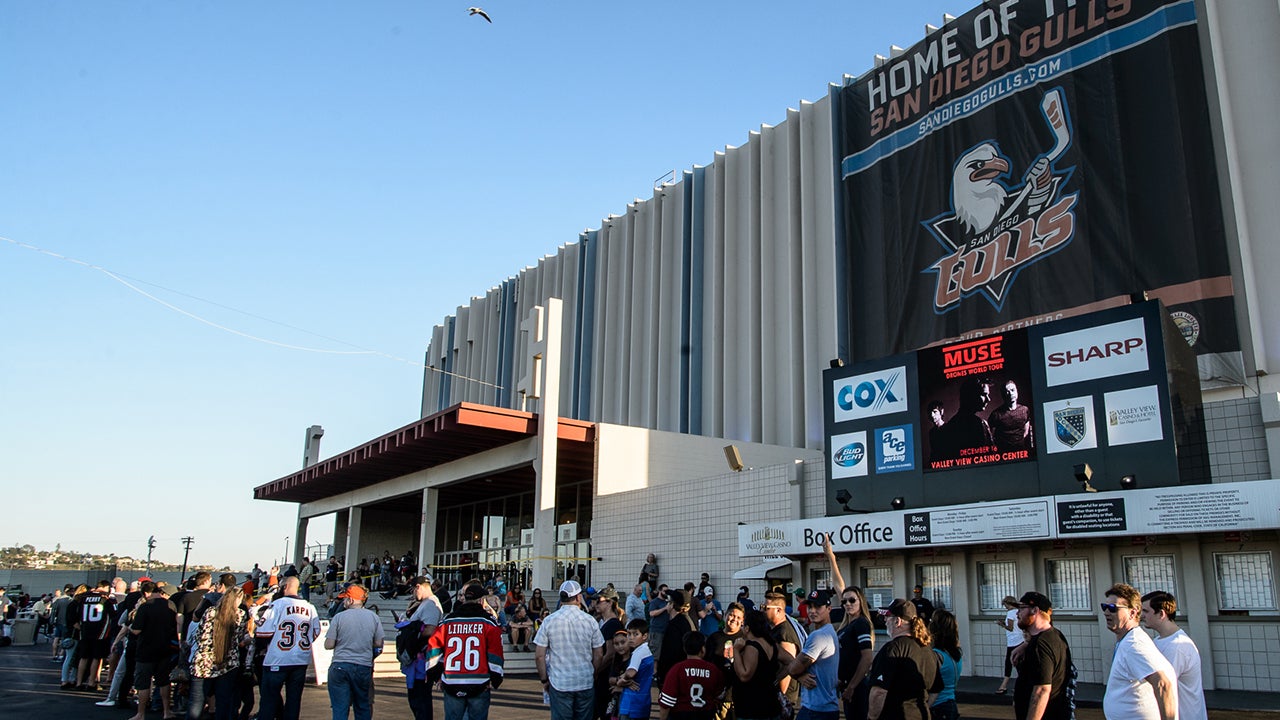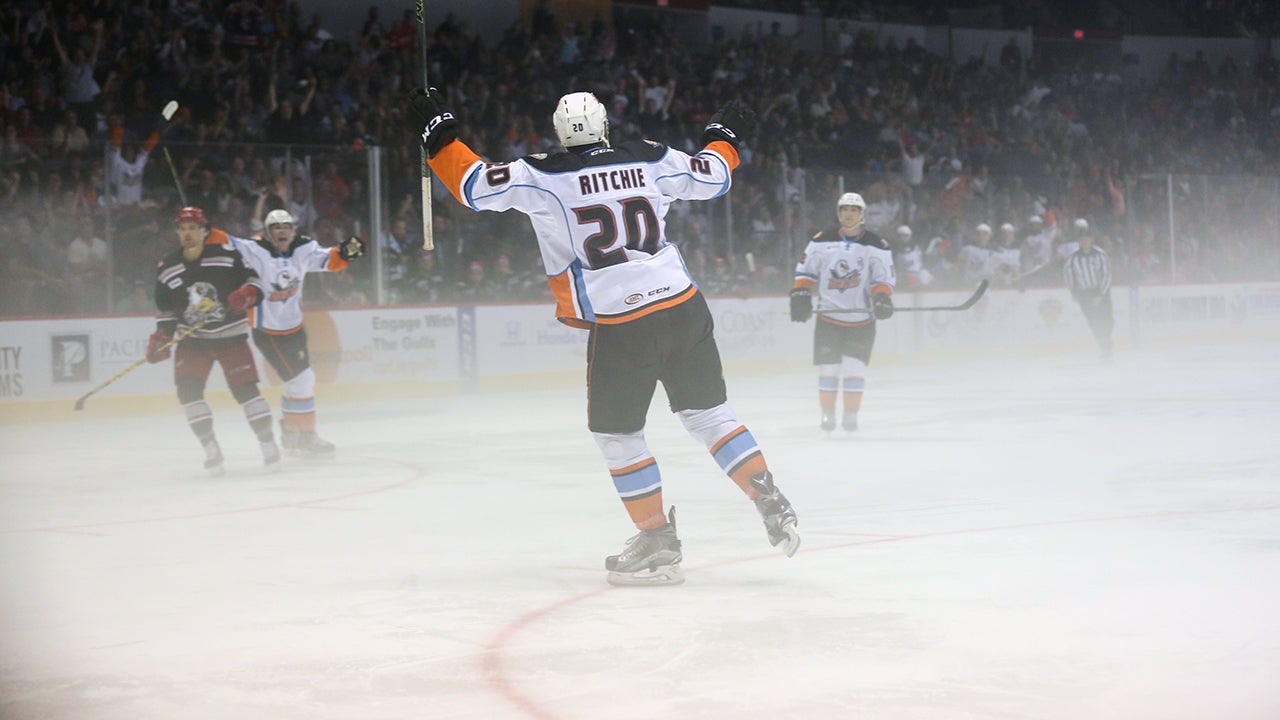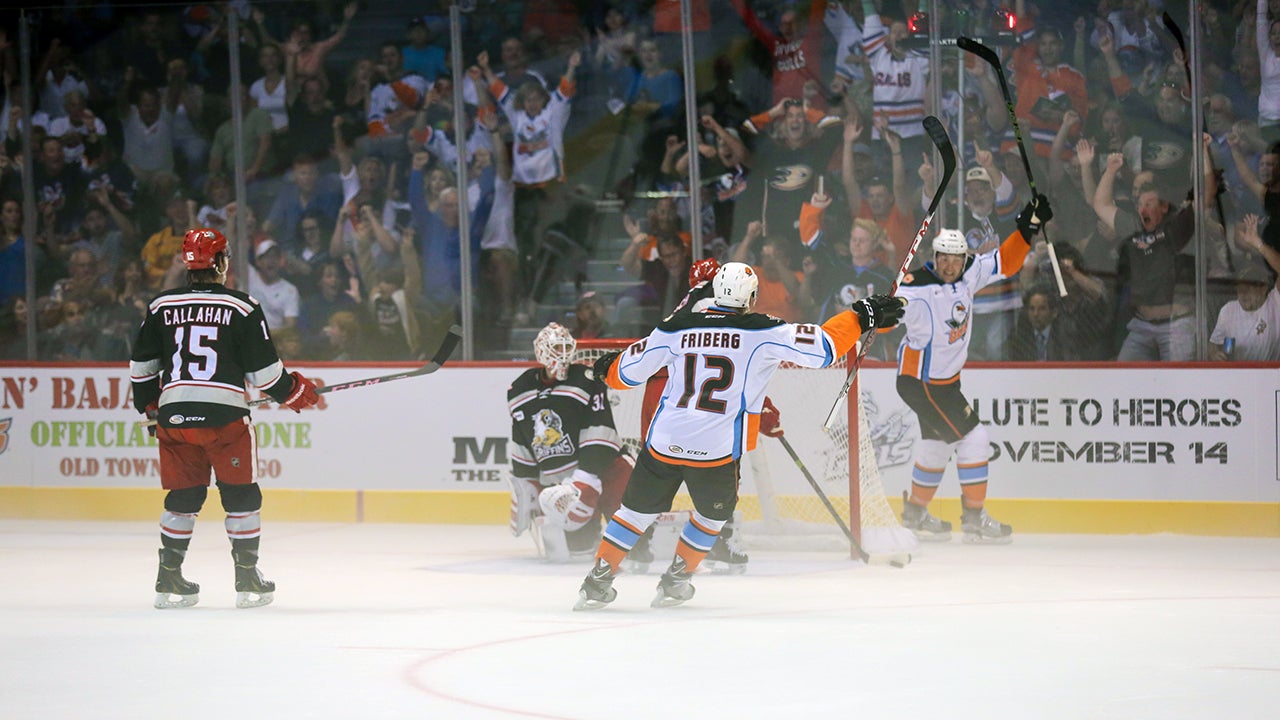A Look Back: Back on the Ice In San Diego
Oct 22, 2020
The third piece of a four-part series, SanDiegoGulls.com provides in depth look at how the Gulls returned to San Diego in 2015, how the team’s brand was launched, the inaugural AHL game in San Diego and the creation of the team’s practice facility in Poway. The series covers the pillar moments as we hear from key members of the organization and community shaping the franchise from day one.
By Andy Zilch/SanDiegoGulls.com
After nine years, six months and two days, hockey finally returned to San Diego.
It took eight-plus months of diligent work, preparation, execution, and more to get the Gulls up and running for their inaugural American Hockey League game when they hosted the Grand Rapids Griffins on Oct. 10, 2015.
Related: Part 1: The Return of the Gulls | Part 2: Building The Brand
A sold out, raucous crowd of 12,920 packed the then-Valley View Casino Center to the rafters to welcome the Gulls back to San Diego. All of these anecdotes would provide excellent storylines and provide recollections for years to come.
The opening game, however, provided unexpected memories that will last a lifetime.
As the day began to unfold, the teams held their morning skate for a final tune-up prior to the main event. There was already nervous energy amongst the players, staff and fans who were anxious to reinstate professional hockey in America’s Finest City.
Ari Segal, the then-Gulls President of Business Operations, noted the energy from a business perspective.
“The only two words better in sports that are better than ‘game seven’ are ‘sell out,’” said Segal. “The whole day we were saying ‘we’re going to get there.’ We were super excited when it became very clear we were going to sell out the building. With something like 4,000 season tickets sold, most people would tell you that getting to a sellout is difficult. The marketing team did an unbelievable job, KUSI and San Diego media got behind it, obviously The Mighty 1090, the local ESPN affiliate, even people who weren’t on our flagship station. People really wanted to have a splash on opening night.”
Those emotions reached all the way up to the ownership group.
Selling out an arena holding 12,920 fans is a daunting task in the AHL. From the time of the purchase of the franchise in Norfolk, this was a target date in their calendar as well. Anaheim Ducks and Gulls owners Henry and Susan Samueli were ready to step up to the plate and provide San Diego with the sport it craved for years.
Needless to say, the region was not disappointed.
“We felt this was a seminal moment in franchise history,” said Henry Samueli prior to the game during a media availability in the arena’s Stella Artois Lounge. “To sell out the arena for the Gulls is a very meaningful thing.”
“We’ve been working toward and looking forward to today for a long time,” added Susan Samueli. “We can’t wait to see our new team on the ice to celebrate the re-launch of the Gulls with the great hockey fans in San Diego.”

A MARQUEE ROSTER
San Diego's inaugural AHL team consisted of a unique and experienced roster. Eight players who skated in at least 20 game with the club were over the age of 28. On the opposite end of the spectrum, the roster saw 12 players under the age of 24 competing in at least 25 games. Some players on the roster were familiar names to the robust hockey fandom in San Diego which added an extra element to watching a minor league team like the Gulls in the inaugural season.
“We had a lot of guys that had played a lot of games in the NHL like Shane O’Brien and Brian McGrattan, a lot of guys you’ve watched play in the NHL,” said former Gulls captain Jaycob Megna in a recent interview. “These guys were still big time and it was pretty cool to have them in your locker room. It was cool to be the first, I’ll say that – to be the inaugural team.”
Regardless of age, experience and games played, everyone was a rookie to San Diego’s first home game. It is a rare occasion for a player to be involved in an inaugural game for a team, let alone in Southern California.
“The whole first year in San Diego was new for everyone,” former Gulls defenseman Brandon Montour added. “My first full pro year, I didn’t expect or know much, and you could say the same for everyone else. The experience grew day one with myself, and everyone in the organization from players and staff. The whole year we had sellouts, fans everywhere, every event was something new and everyone’s experiences are great memories. I’ll never forget it.”

THE FOG ROLLS IN
One immediate challenge presented itself on the team's opening night - the Southern California climate. San Diego's average October temperatures aren't friendly to a frozen sport, and posted challenges for those prepping the building for the festivities. It nearly ended the day before it began. On opening night, the issue brought with it anxiety, fear and concern. As most reflect on it five-plus years later, its met with a smile.
The issue - fog.
“I remember in the parking lot that day it was almost 100 degrees and the doors would have been open with 13,000 people coming to it and when you put a hockey rink half a mile away from the biggest body of water in the world and 100 degrees outside, it’s not a good combination,” said Ferguson. “Of course, once the doors opened and people started coming in, the fog started to develop. I don’t think anyone was expecting a professional hockey game with 13,000 people in the rink, and the fact that we had to continually stop play and skate around and lift it but hey, it all worked out.”
The blend of opening night - and the inaugural puck drop for the Gulls - created a magical event. All fans look forward to the in-game entertainment, warm-ups, player introductions, the hype video and team taking to the ice for the first time. Leave no doubt, the build up reached peak levels before the puck drop.
“There was a lot going on that first game: pyrotechnics, the ice being soft, the fog, new staff for the team and the arena working hockey games for the first time, or for the first time in almost 10 years,” then-head equipment manager Matt Brayfield said. “(Former Gulls netminder) John Gibson came to the bench asking what we were doing in the arena. He couldn’t see the other end. We’re lucky we finished the game. Skate in circles, play again, and repeat that over and over. It was definitely a different experience. It’s a game I’ll never forget.”
While it provides a great memory, in the moment, everyone in the organization moved with a frantic energy to ensure the game would start - and finish - without any further problems. The arena staff continually attempted to ease the issues not only with the fog but with the ice itself. Stoppages in play provided the staff an opportunity to safeguard the playing conditions but needed help from 40 men on the ice.
“Both teams were skating around during media timeouts on the ice trying to get the fog out,” Montour added. “I’ll always remember that. We were just as excited as the fans were with the whole buildup, that whole first game of the hiccups and how loud it was in the arena. We had a strong season, a strong playoff push. The whole season was exciting for us and the fans. It showed the AHL that we were the best place to play.”
As the game continued, the issue continued to worsen. At one point, officials called then-President and CEO of the AHL, David Andrews, down to ice level to discuss the problems and air concerns to cancel the game. A marquee day for the franchise - one circled on its calendar since the team announced its move to San Diego - could end without resolution.
“Dave basically puts them (the officials) on pause and goes and talks to Dallas Eakins,” Segal recounted. “Dallas had known Dave because Dallas was a long-time AHL player and very successful AHL coach and they had a really great relationship. They had kind of a sidebar for a minute or two minutes and my heart is in my throat because if Dallas says we can’t go on, Dave is going to listen to him.
“Dave comes back and hears the officials out,” added Segal. “Then he says something like ‘do you guys hear that. Then he goes, ‘We’re finishing this game.’ He said it in a way that was not super serious, he said it in a way that broke the tension. It was, if there is a real health and safety issue here, I’m here, I will stay at ice level, I will stay along the glass until this game gets concluded. This is a special night for these players, for these coaches, for these fans. Let’s work together to try to get the game in. Dave has this very wry sense of humor. It was the little bit of air out of the balloon that the officials needed to get the game done.”
The organization overcame its issues and successfully completed the game, providing a lasting memory for everyone on and off the ice.

HOME SWEET HOME
As time ticked down in regulation, the Gulls clung to a one-goal lead. A storybook ending hung in the balance as Grand Rapids pulled their goalie in attempt to tie the game. The action matched the temperature in the building, with the Griffins making a desperate push to find the back of the net. A hero emerged for the Gulls, as forward Antoine Laganiere tallied an empty-net goal to seal the victory San Diego grabbed a 4-2 win.
The night did not deter anyone; in fact, it invigorated the city to consistently revisit one of their favorite sports. During the course of the first season, the Gulls averaged 8,675 fans per game, just shy of the Hershey Bears for the best average attendance in the AHL, a team with 80 years of AHL history. The Gulls led the entire Western Conference in attendance the inaugural season, quite a feat for the organization, staff, fans and community.
“The whole first year in San Diego was new for everyone,” said Montour . “My first full pro year, I didn’t expect or know much, and you could say the same for everyone else. The experience grew day one with myself, and everyone in the organization from players and staff. The whole year we had sellouts, fans everywhere, every event was something new and everyone’s experiences are great memories. I’ll never forget it.”
Attendance continued to climb over future seasons, with a landmark 2017-18 season for the organization and for the community. San Diego led the AHL in attendance, ending the Bears consecutive record of 11 seasons atop the league. Over the course of the season, the Gulls averaged 9,305 fans. San Diego nearly duplicated that feat the very next season with an average of 9,021, again leading the AHL.
“Nobody really knew what was going to happen with this whole division out here,” added Ferguson. “We knew it was coming because San Diego has been such a great hockey town going all the way back to the 40’s. It’s always been a successful hockey town. They have won championships here at different levels and I remember growing up reading articles about how great of a hockey town San Diego was and how they drew the best minor league hockey crowds in the league.”
While success was never guaranteed, the Gulls installed key pieces as they built toward the first game. Investing in its staff in the summer of 2015 - and leading into this inaugural game - put the team on the right path.
“Go back to that very first game how people embraced us and I don’t want to say we tried to sell the franchise but just sold that there are players that you are going to see here that you can see the next night playing in the NHL, and that season a lot of them were,” added Ferguson. “You see players like Gibson, Theodore and Nick Ritchie who had a great start with us and played 10 games of the season and were up in the NHL. Everything came as advertised both on and off the ice.”